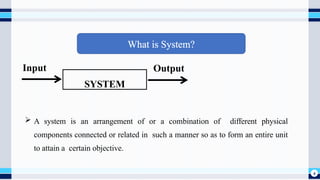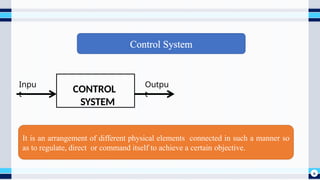Introduction to control engineering.pptx
- 1. Prof. Sankalp Bhatia Assistant Professor Mechanical Engineering Department A. D. PATEL INSTITUTE OF TECHNOLOGY New Vallabh Vidyanagar INTRODUCTION TO CONTROL ENGINEERING
- 2. 2 What is Input? ’āś The stimulus or excitation applied to a control system from an external source in order to produce the output is called input. Input
- 3. 3 What is Output? Output Input ’āśThe actual response obtained from a system is called output.
- 4. 4 What is System? SYSTEM Input Output ’āś A system is an arrangement of or a combination of different physical components connected or related in such a manner so as to form an entire unit to attain a certain objective.
- 5. 5 ’āś To regulate, direct or command a system so that the desired objective is attained. What is Control? System + Control = Control System
- 6. 6 Control System CONTROL SYSTEM Inpu t Outpu t It is an arrangement of different physical elements connected in such a manner so as to regulate, direct or command itself to achieve a certain objective.
- 7. 7 Difference between System & Control System System Inpu t Control System Inpu t Desired Outpu t Proper Outpu t (May or may not be desired)
- 8. 8 Difference between System & Control System Fan (System ) 230V/ 50Hz AC Supply Air Flow Input Outpu t
- 9. 9 A Fan: CanŌĆÖt say a System Output Input ’āś A Fan without blades cannot be a ŌĆ£SYSTEMŌĆØ Because it cannot provide a desired / proper output. i.e. airflow
- 10. 10 ’āś A Fan with blades but without regulator can be a ŌĆ£SYSTEMŌĆØ Because it can provide a proper output. i.e. Airflow ’āś But it cannot be a ŌĆ£Control SystemŌĆØ Because it cannot provide desired output i.e. Controlled Airflow A Fan: Can be a System Input Outpu t
- 11. 11 ’āś A Fan with blades and with regulator can be a ŌĆ£CONTROL SYSTEMŌĆØ Because it can provide a Desired Output. i.e. Controlled Airflow A Fan: Can be a Control System
- 12. 12 Classification of Control System (Depending on control action)
- 13. 13 ŌĆ£A system in which the control action is totally independent of the output of the system is called as open loop systemŌĆØ Definition: Open Loop System Block Diagram of Open loop Control System
- 14. 14 ŌĆó Electric hand drier ŌĆō Hot air (output) comes out as long as you keep your hand under the machine, irrespective of how much your hand is dried. Example of Open Loop System
- 15. 15 ’āś Automatic washing machine: This machine runs according to the pre-set time irrespective of washing is completed or not. Example of Open Loop System
- 16. 16 ŌĆó Bread Toaster: This machine runs as per adjusted time irrespective of toasting is complete or not. Example of Open Loop System
- 17. 17 ŌĆó Automatic tea/coffee Vending Machine: These machines also function for pre adjusted time only. Example of Open Loop System
- 18. 18 ŌĆó Light Switch: Lamps glow whenever light switch is on irrespective of light is required or not. ŌĆó Volume on Stereo System : Volume is adjusted manually irrespective of output volume level. Example of Open Loop System
- 19. 19 ’āś Simple in construction and design ’āś Economical ’āś Easy to maintain ’āś Generally stable ’āś Convenient to use as output is difficult to measure Advantages of Open Loop System
- 20. 20 ’āśInaccurate ’āśUnreliable ’āśAny change in output canŌĆÖt be corrected automatically Disadvantages of Open Loop System
- 21. 21 ŌĆ£A system in which the control action is somehow dependent on the output is called as closed loop systemŌĆØ. Definition of Close Loop System
- 22. 22 Block Diagram of Close Loop System
- 23. 23 ’āś Automatic Electric Iron : Heating elements are controlled by output temperature of the iron. Example of Close Loop System
- 24. 24 ’āś Servo Voltage Stabilizer: Voltage controller operates depending upon output voltage of the system. Example of Close Loop System
- 25. 25 Perspiration Example of Close Loop System
- 26. 26 ’āś Closed loop control systems are more accurate even in the presence of non-linearity ’āś Highly accurate as any error arising is corrected due to presence of feedback signal ’āś Bandwidth range is large ’āś Facilitates automation ’āś The sensitivity of system may be made small to make system more stable ’āś This system is less affected by noise Advantages of Close Loop System
- 27. 27 ’āś They are costlier ’āś They are complicated to design ’āś Required more maintenance ’āś Feedback leads to oscillatory response ’āś Overall gain is reduced due to presence of feedback ’āś Stability is the major problem and more care is needed to design a stable closed loop system Disadvantages of Close Loop System
- 28. 28 Difference between Open Loop & Close Loop System
- 29. 29 Visit our website www.adit.ac.in Connect with us Follow us on social media and be the first to find out about our announcements and Events! Thank You





























